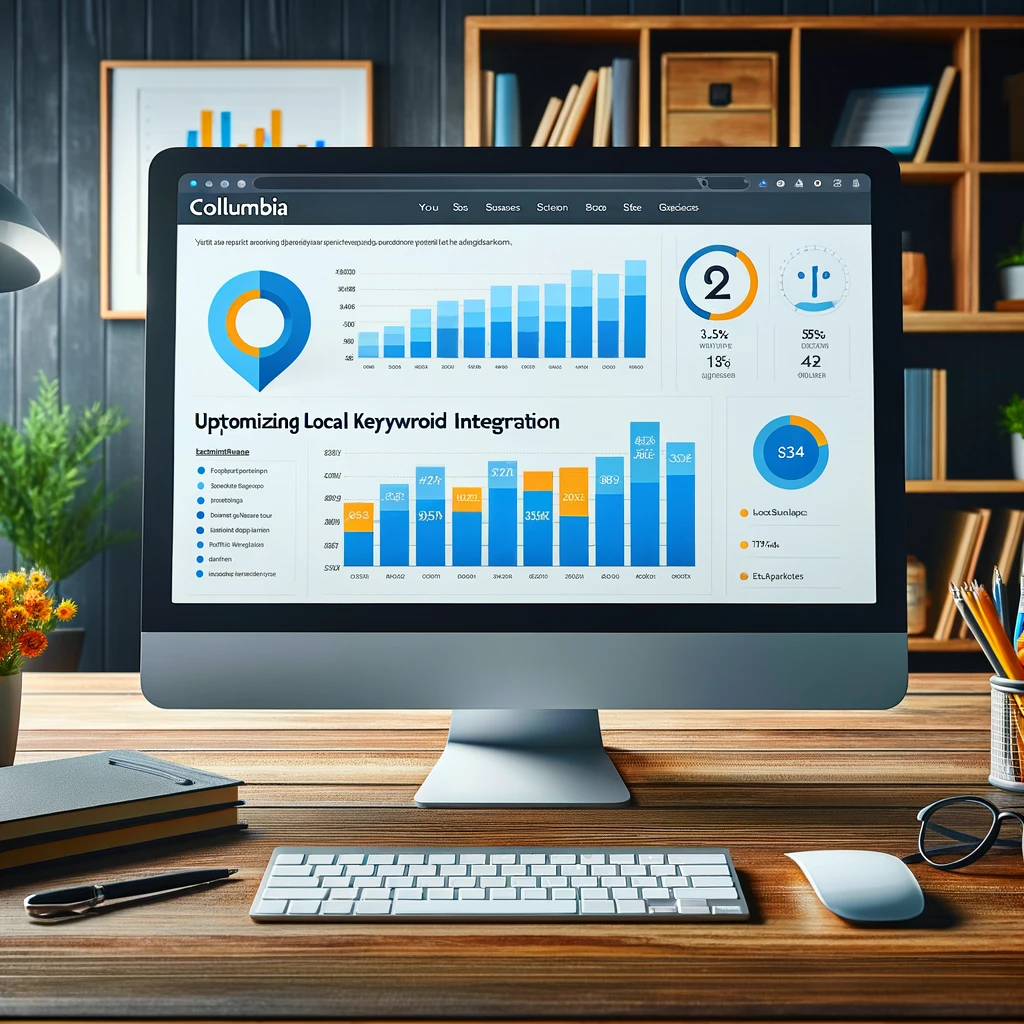Introduction

Hey there, local Columbia business owners, today we’re focusing on how web design and SEO impact your searchability! Are you looking to give your website a little extra edge in the search engines? Well, you’re in the right place. In today’s digital age, having a website that not only looks good but also ranks well in search results is crucial for attracting more visitors and ultimately, more customers.
But how exactly does a well-designed website improve your SEO? It’s all about making your site not just beautiful, but smart and speedy too. From the way it’s structured to how quickly it loads, every detail of your web design can influence how well you rank in search results.
In this guide, we’ll dive into the specifics of how you can tweak your website design to boost your SEO. We’ll cover everything from the importance of mobile responsiveness to the power of the right local keywords. So, let’s get started and turn your site into a lean, mean, SEO-friendly machine!
Understanding SEO and Web Design

Hey, let’s unpack this a bit! When we talk about SEO, or Search Engine Optimization, we’re diving into the ways your website can attract more natural traffic from search engines like Google. And guess what? The design of your website plays a huge part in that.
Basic Principles of SEO
- Keywords: These are the terms that people use when searching for services or products like yours. Your job is to weave these naturally into your website’s text.
- Metadata: This includes the titles and descriptions that appear in search results. It’s like the mini-advertisement for your content!
- Site Structure: How your website is organized affects both user experience and how search engines index your pages.
How Web Design Influences SEO
- Site Speed: If your site loads quickly, users are happier and search engines rank it higher.
- Mobile Responsiveness: With more people browsing on their phones, your site must look good on any device.
- User Experience (UX): A well-designed website helps visitors find what they need quickly and easily, reducing bounce rates and improving your rankings.
Understanding these fundamentals can help you see how deeply intertwined design and SEO really are. A great design isn’t just visually appealing—it’s structured in a way that search engines love. Now that’s a win-win!
Keyword Optimization

Alright, let’s dive into one of the keystones of SEO: Keyword Optimization. It’s like choosing the right bait for fishing—it’s all about attracting the right visitors to your site.
Importance of Local Keywords for Columbia Businesses
For you, a local business in Columbia, it’s crucial to target geographic-specific keywords. This means incorporating terms like “Columbia,” “Midlands,” or even specific neighborhood names into your keywords. Why? Because when locals are searching for services or products you offer, you want to make sure your business pops up on their radar.
Tips for Integrating Local Keywords into Website Content Effectively
- Natural Placement: Sprinkle your local keywords throughout your content, but keep it natural. Forced or awkward stuffing of keywords can turn off visitors and hurt your SEO.
- Include in Key Areas: Make sure to include local keywords in your title tags, meta descriptions, headings, and main content. This helps search engines understand what your page is about and shows relevance to local searches.
- Use in Alt Text for Images: Don’t forget the images! Using local keywords in the alt text for images can boost your SEO further, making your visuals work harder for you.
Getting your keyword strategy right doesn’t just help with search engines; it makes your website more relevant to the local community. This can increase traffic and engagement, which are gold for any business.
Improving Site Structure for SEO

Alright, let’s shift gears and talk about the backbone of your website—its structure. Just like a well-organized closet makes it easier to find what you need, a well-structured website makes it easier for both users and search engines to navigate.
Best Practices for a Logical, Hierarchical Site Structure
A logical site structure isn’t just about aesthetics; it’s about functionality. Here’s how to get it right:
- Hierarchy: Start with a clear hierarchy that logically categorizes your content from general to specific. This helps users and search engines understand the relationships between different parts of your site.
- Simplicity: Keep it simple. A complex site structure can confuse users and search engines, potentially burying important content.
Importance of URL Structure
URL structure plays a pivotal role in SEO. Well-structured URLs are clear and descriptive—they should give users an idea of what to expect on the page just by looking at the URL. Here are a few tips:
- Readable URLs: Use words that clearly indicate the content of the page, and avoid long IDs or numbers.
- Keyword Usage: Include relevant keywords in your URLs, but avoid keyword stuffing.
Breadcrumb Navigation
Breadcrumb navigation is not just a helpful tool for your visitors to keep track of their locations on your site; it also provides SEO benefits:
- Navigation Clues: Breadcrumbs provide clear paths or trails to how pages are related and ranked.
- Reduced Bounce Rate: By providing an easy navigation option, breadcrumbs can reduce the bounce rate and improve the user experience.
Improving your site structure for SEO can greatly enhance your site’s visibility and user experience. It’s like laying down a clear map that leads users (and search engines) right to your content.
Enhancing Website Speed

Hey there! Let’s zoom into another critical aspect of your website’s SEO and user experience—website speed. Did you know that a delay of just a few seconds in page load time can significantly increase bounce rates and reduce user satisfaction? Speed matters, and here’s how you can put the pedal to the metal on your site.
Why Website Speed is Crucial
- User Experience: Fast-loading pages keep users happy and engaged. No one likes waiting, especially online.
- SEO Rankings: Search engines, like Google, prioritize faster websites in their rankings because they provide a better user experience.
Tools and Techniques to Improve Website Loading Times
- Optimize Images: Large images can slow down your pages. Use image compression tools to reduce file sizes without losing quality.
- Minimize HTTP Requests: Reduce the number of elements on your page to decrease the number of HTTP requests required to load the page.
- Use a Content Delivery Network (CDN): CDNs distribute your content across multiple servers around the world, reducing the distance data travels to reach users and speeding up load times.
- Enable Browser Caching: When you enable caching, returning visitors can load your page faster since their browser saves elements of your site.
Enhancing your website speed is not just about boosting your rankings; it’s about creating a smoother, more enjoyable experience for your visitors. And happy visitors are more likely to convert into happy customers.
Mobile Optimization

Hey there! Let’s talk about making your website not just mobile-friendly but mobile-optimized. With most users now accessing the web via smartphones and tablets, ensuring your site performs flawlessly on these devices isn’t just a nice-to-have—it’s essential.
Why Mobile Optimization Matters
- Reach More Users: Many of your customers are browsing on the go. A mobile-optimized site ensures they can access your site anytime, anywhere.
- Boost SEO: Search engines like Google prioritize mobile-friendly websites in their search results, especially after their shift to mobile-first indexing.
How to Ensure Your Website is Fully Optimized for Mobile Users
- Responsive Design: This means your site automatically adjusts to fit the screen it’s viewed on, whether it’s a desktop, a tablet, or a smartphone.
- Touch Controls: Make sure buttons and links are easy to navigate using a finger, not a mouse cursor. They should be big enough to tap easily without zooming.
- Optimize Images and Media: Compress images and videos so they don’t slow down your mobile site’s loading time.
Implementing these mobile-first strategies will not only enhance the user experience but also improve your site’s performance and visibility in search rankings.
Creating Quality Content

Alright, let’s talk content! Quality content is the heart of any successful website, and when it comes to SEO, it’s your golden ticket. Not only does it help you connect with your audience, but it also boosts your visibility on search engines. So, how do you get it right?
The Role of Engaging, Valuable Content in SEO
- Engagement: High-quality content keeps visitors on your page longer, reducing bounce rates and increasing the likelihood of conversions.
- Keywords: Naturally integrating keywords into your content helps search engines understand and rank your pages better.
Tips for Creating Content That Resonates
- Understand Your Audience: Know what your Columbia-based audience needs and wants. This insight will guide the tone, style, and topics of your content.
- Be Helpful: Provide value through how-to guides, insights, and informative posts that address common questions or needs.
- Storytelling: Use real-life examples, customer stories, or case studies to make your content relatable and engaging.
Creating compelling content isn’t just about filling pages; it’s about speaking directly to your audience’s interests and solving their problems. This approach not only improves SEO but also builds trust and loyalty with your customers.
Using Social Media to Boost SEO

Hey there! Let’s dive into how leveraging social media can supercharge your SEO efforts. It’s not just about posting fun photos or updates; when used strategically, social media can significantly enhance your website’s search engine visibility.
The Impact of Social Media on SEO
- Increased Exposure: Sharing your content on social media platforms can drive more traffic to your website. Each share introduces your content to a new network of individuals, increasing your online presence.
- Link Building: While social media links themselves don’t contribute directly to SEO rankings, they can lead to organic links from other websites. If someone discovers your content via social media and decides to link it from their blog or website, it boosts your link equity.
Strategies for Leveraging Social Media to Enhance SEO Efforts
- Consistent Posting: Keep your brand top of mind by maintaining a regular posting schedule. This keeps your audience engaged and drives steady traffic back to your site.
- Optimize Social Media Profiles: Make sure your social media profiles are fully optimized with up-to-date information, keywords, and links to your website.
- Engage With Your Audience: Engagement (likes, comments, shares) can indirectly influence your SEO. More engagement leads to greater visibility, potentially resulting in more shares and links.
- Use Hashtags Strategically: Hashtags can increase the reach of your posts and help you connect with new followers who might be interested in your content.
Social media isn’t just a marketing tool—it’s a powerful SEO ally that can help you reach a broader audience and drive more traffic to your website. So, get social, be strategic, and watch your SEO soar!
Conclusion

And just like that, we’ve covered a lot of ground! From tweaking your website design to optimize SEO to harnessing the power of social media, it’s clear that there are many ways Columbia businesses can enhance their online visibility and reach. Remember, SEO isn’t just about climbing the search engine rankings; it’s about making your website more accessible, engaging, and valuable to your audience.
Keep Evolving
The digital landscape is always changing, and so should your strategies. Stay updated with the latest SEO practices and continuously adapt your approach to stay ahead of the curve.
Stay Engaged
Engage with your audience and build relationships through quality content and active social media presence. The more connected your audience feels with your brand, the more likely they are to stick around.
Never Stop Learning
Whether it’s through online courses, webinars, or articles, keep learning about new tools and techniques to enhance your SEO and overall digital marketing strategies.
Your journey to improving your website’s SEO is ongoing, and every little bit helps. By applying the insights and strategies we’ve discussed, you’ll not only boost your search engine presence but also create a more delightful and effective online experience for your customers. Here’s to your success in making your mark online!
Live in Columbia SC and need assistance with your SEO and Web Design? Schedule a Free Consultation